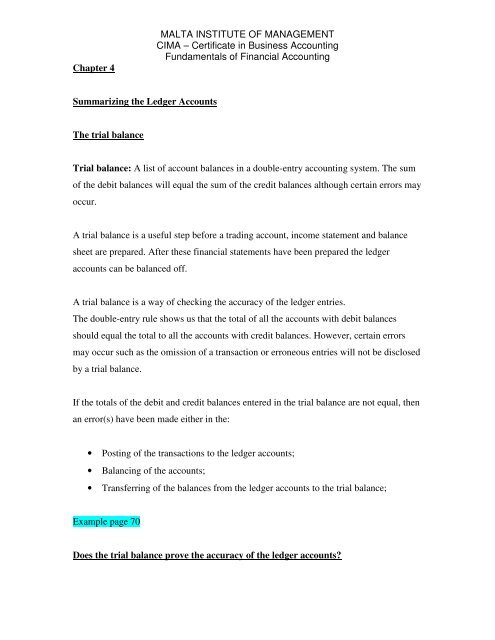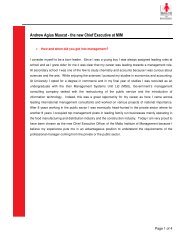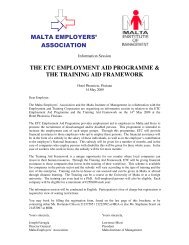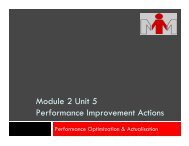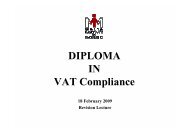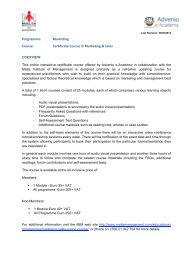Certificate in Business Accounting Fundamentals of Financial ...
Certificate in Business Accounting Fundamentals of Financial ...
Certificate in Business Accounting Fundamentals of Financial ...
You also want an ePaper? Increase the reach of your titles
YUMPU automatically turns print PDFs into web optimized ePapers that Google loves.
Chapter 4<br />
MALTA INSTITUTE OF MANAGEMENT<br />
CIMA – <strong>Certificate</strong> <strong>in</strong> Bus<strong>in</strong>ess Account<strong>in</strong>g<br />
<strong>Fundamentals</strong> <strong>of</strong> F<strong>in</strong>ancial Account<strong>in</strong>g<br />
Summariz<strong>in</strong>g the Ledger Accounts<br />
The trial balance<br />
Trial balance: A list <strong>of</strong> account balances <strong>in</strong> a double-entry account<strong>in</strong>g system. The sum<br />
<strong>of</strong> the debit balances will equal the sum <strong>of</strong> the credit balances although certa<strong>in</strong> errors may<br />
occur.<br />
A trial balance is a useful step before a trad<strong>in</strong>g account, <strong>in</strong>come statement and balance<br />
sheet are prepared. After these f<strong>in</strong>ancial statements have been prepared the ledger<br />
accounts can be balanced <strong>of</strong>f.<br />
A trial balance is a way <strong>of</strong> check<strong>in</strong>g the accuracy <strong>of</strong> the ledger entries.<br />
The double-entry rule shows us that the total <strong>of</strong> all the accounts with debit balances<br />
should equal the total to all the accounts with credit balances. However, certa<strong>in</strong> errors<br />
may occur such as the omission <strong>of</strong> a transaction or erroneous entries will not be disclosed<br />
by a trial balance.<br />
If the totals <strong>of</strong> the debit and credit balances entered <strong>in</strong> the trial balance are not equal, then<br />
an error(s) have been made either <strong>in</strong> the:<br />
• Post<strong>in</strong>g <strong>of</strong> the transactions to the ledger accounts;<br />
• Balanc<strong>in</strong>g <strong>of</strong> the accounts;<br />
• Transferr<strong>in</strong>g <strong>of</strong> the balances from the ledger accounts to the trial balance;<br />
Example page 70<br />
Does the trial balance prove the accuracy <strong>of</strong> the ledger accounts?
MALTA INSTITUTE OF MANAGEMENT<br />
CIMA – <strong>Certificate</strong> <strong>in</strong> Bus<strong>in</strong>ess Account<strong>in</strong>g<br />
<strong>Fundamentals</strong> <strong>of</strong> F<strong>in</strong>ancial Account<strong>in</strong>g<br />
Although the trial balance totals may agree, this does not mean that there are no errors<br />
with<strong>in</strong> the ledger accounts. There are a number <strong>of</strong> errors that might have been made that<br />
do not prevent the trial balance from agree<strong>in</strong>g.<br />
These are:<br />
• Errors <strong>of</strong> omission: a transaction has been completely omitted from the ledger<br />
accounts<br />
• Errors <strong>of</strong> commission: one side <strong>of</strong> a transaction has been entered <strong>in</strong> the wrong<br />
account.<br />
• Errors <strong>of</strong> pr<strong>in</strong>ciple: the correct and <strong>in</strong>correct accounts are <strong>of</strong> different types. This<br />
type <strong>of</strong> error would affect the calculation <strong>of</strong> pr<strong>of</strong>it, and the position shown by the<br />
balance sheet.<br />
• Errors <strong>of</strong> orig<strong>in</strong>al entry: the wrong amount has been used for both the debit and<br />
the credit entries.<br />
• Reversal <strong>of</strong> entries: the debit has been made to the account that should have been<br />
credited and vice versa.<br />
• Duplication <strong>of</strong> entries: the transaction has been posted twice.<br />
• Compensat<strong>in</strong>g errors: two or more transactions have been entered <strong>in</strong>correctly, but<br />
cancell<strong>in</strong>g each other out.<br />
Example page 71,72<br />
Prepar<strong>in</strong>g a statement <strong>of</strong> pr<strong>of</strong>it<br />
After complet<strong>in</strong>g the trial balance, the pr<strong>of</strong>it can be calculated, this is referred to as an<br />
<strong>in</strong>come statement. The part <strong>of</strong> the <strong>in</strong>come statement that calculates the gross pr<strong>of</strong>it is<br />
known as the ‘trad<strong>in</strong>g account’, this is a sub section <strong>of</strong> the <strong>in</strong>come statement. This<br />
comprises sales, less cost <strong>of</strong> goods sold which equals gross pr<strong>of</strong>it.<br />
The trad<strong>in</strong>g account
MALTA INSTITUTE OF MANAGEMENT<br />
CIMA – <strong>Certificate</strong> <strong>in</strong> Bus<strong>in</strong>ess Account<strong>in</strong>g<br />
<strong>Fundamentals</strong> <strong>of</strong> F<strong>in</strong>ancial Account<strong>in</strong>g<br />
The trad<strong>in</strong>g account is part <strong>of</strong> the double-entry bookkeep<strong>in</strong>g <strong>of</strong> an organisation with the<br />
<strong>in</strong>tention <strong>of</strong> mak<strong>in</strong>g pr<strong>of</strong>it. The trad<strong>in</strong>g account is part <strong>of</strong> the <strong>in</strong>come statement and is<br />
produced regularly by an organisation.<br />
The trad<strong>in</strong>g account compares revenue derived from sell<strong>in</strong>g the goods with the costs <strong>of</strong><br />
obta<strong>in</strong><strong>in</strong>g the goods sold.<br />
Example page 72<br />
Transferr<strong>in</strong>g the balances to the trad<strong>in</strong>g account<br />
Every entry <strong>in</strong> the trad<strong>in</strong>g account must have an opposite entry elsewhere <strong>in</strong> the ledger<br />
accounts (double entry-rule).<br />
Example: the credit <strong>in</strong> the trad<strong>in</strong>g account for sales will also be debited <strong>in</strong> the sales<br />
account.<br />
Example page 73<br />
When the accounts are balanced, that is, the totals <strong>of</strong> both sides are equal, they should be<br />
ruled <strong>of</strong>f to prevent <strong>in</strong>clud<strong>in</strong>g them <strong>in</strong> the figures for the follow<strong>in</strong>g year. The account is<br />
now said to be closed, although it can still be used to record the sales for the next period.<br />
In the <strong>in</strong>ventories account there will be a balance at the start <strong>of</strong> the period, which will be<br />
a debit balance.<br />
As the trad<strong>in</strong>g account is be<strong>in</strong>g prepared, a balance is transferred <strong>in</strong>to it, by credit<strong>in</strong>g the<br />
<strong>in</strong>ventories account and debit<strong>in</strong>g the trad<strong>in</strong>g account.<br />
When the <strong>in</strong>ventory account is balanced it can be closed <strong>of</strong>f with the sales account.<br />
As the preparation <strong>of</strong> the trad<strong>in</strong>g account cont<strong>in</strong>ues, it will be necessary to determ<strong>in</strong>e the<br />
value <strong>of</strong> the <strong>in</strong>ventories at 31 December. This is <strong>of</strong>ten done by referr<strong>in</strong>g to a separate<br />
<strong>in</strong>ventory control system, which is ma<strong>in</strong>ta<strong>in</strong>ed outside the bookkeep<strong>in</strong>g system. The<br />
figure is passed to the bookkeeper, who debits the <strong>in</strong>ventories account with the new<br />
value, and credits the trad<strong>in</strong>g account.


